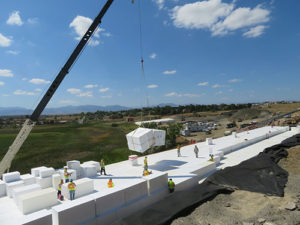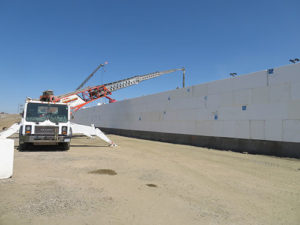U.S. 36, CO: Insulfoam’s Geofoam Enables Colorado to Rebuild Major Highway in Mere Months
On July 12, 2019, cracks appeared on the eastbound lanes of U.S. 36 between Wadsworth and Church Ranch Boulevards, a heavily trafficked thoroughfare that connects Boulder with Denver, Colorado. The cracks soon gave way to a full-blown sinkhole, according to a Colorado of Department of Transportation (CDOT) press release. While fortunately no one was hurt in the collapse, significant damage led to the partial closure of U.S. 36.
In order to rebuild the damaged roadway as quickly and safely as possible, CDOT and their Design Team which consisted of RJ Engineering and Consulting, Inc and David Evans and Associates, Inc conceptually developed a lightweight geofoam fill option to replace the wall. Based on other successful geofoam projects that Ben Arndt of RJ Engineering had designed for CDOT in the past, Arndt suggested a geofoam fill to meet the timeline requests from CDOT. CDOT awarded the contractor portion of the project to Kraemer North America to rebuild the roadway section.
Kraemer North America looked to Insulfoam’s Geofoam EPS22 product to meet CDOT’s requirements. Based on press releases from CDOT, the expanded polystyrene (EPS) geo-synthetic fill is “very strong, which means it can safely support highway loading and also lead to improved slope stability. Of the different options considered, (…) (EPS Geofoam) provides the best factor of safety.” Matt Hogan, project manager for Kraemer, further explains, with EPS “geofoam, we could fabricate quickly and not need all the deep foundation work to support the load of the new wall system.”

Working within a tight deadline to get the roadway open and fully operational, it was all hands-on deck at Insulfoam to manufacture over 6,100 eight-foot blocks of material fill. Six multi-operational manufacturing plants in Aurora, Colorado; Mead, Nebraska; Phoenix, Arizona; Lakeland, Florida; Puyallup, Washington; and Dixon, California rallied to meet this great need and pull the freight numbers together, said Kris Essex, Territory Sales Manager for Insulfoam in Colorado. The plants also remained fully operational, conducting regular business. Essex continued: “This was a great opportunity to work as a team on the production side. We went from 0 to 100 MPH in an instant.”
Hogan also cites timing as a critical factor: “Being able to use six different plants across the country helped. We were able to find, honestly, the fastest producer to be able to meet the needs of this particular project.”
Unprecedented in scope, Insulfoam’s large-scale, multi-site effort was necessary to meet CDOT’s October 2019 re-opening deadline. Additional time-savings came from the manufacturer’s ability to create 40″ x 48″ x 96″ customized EPS geofoam to meet CDOT’s exact requirements. These large block sizes can be produced to fill huge volumes, saving additional time and labor on the Colorado jobsite. For Hogan and his team, the ease of installation was particularly noteworthy. With Insulfoam’s EPS geofoam, “The nice part is being able to train people very quickly, because it’s literally stacking blocks. We’re able to slide the foam right into place,” Hogan said.
EPS geofoam’s physical properties also lent themselves well to rebuilding the major highway. With typical densities from 0.70 to 2.85 lb/ft3 (11.2 to 45.7 kg/m3), EPS geofoam is significantly lighter than soil (approximately 120 lb/ft3). And “Since geofoam is lightweight, it reduces pressure and stress to the underlying soil,” stated the CDOT in a “US 36 Weekly Update.”

The geo-synthetic fill further consists of blocks that are uniform. This is not the case with soil and other fill materials, whose inconsistent compositions can lead to non-uniform load transfer and differential settlement. On the other hand, EPS geofoam’s unique load disbursement capability minimizes post-construction settling, resulting in a more stable foundation.
As Essex explains, “Insulfoam’s (EPS) geofoam is a stable compound right away, as you can engineer the right density. There’s settlement compaction with soil, and there’s not time for that with the main U.S. 36 thoroughfare currently closed down.”
In just 20 days, six Insulfoam plants manufactured and coordinated logistics for over 200 truckloads of EPS geofoam during the busiest month of the year, helping CDOT’s emergency road repair stay on track. It truly takes a village.

